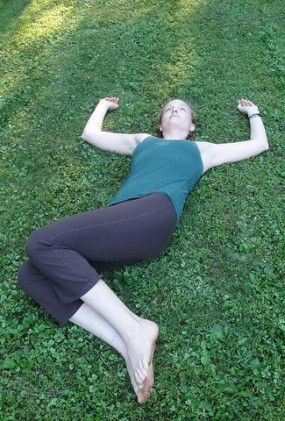|
http://triathlon.competitor.com/2011/08/training/three-yoga-poses-for-triathletes_36912 Appeared on http://triathlon.competitor.com/ August 18, 2011 Spending time stretching and focusing on key areas will help you gain more flexibility, strength and balance. By: Meghan Collins Fanning Yoga will make you a better athlete. Spending time stretching and focusing on key areas will help you gain more flexibility, strength and balance. It will also help you become stronger mentally. Yoga can also help to prevent injuries. You can benefit by adding a few yoga poses to your training. The following poses will strengthen and release your IT band and your back. Also, don’t forget your recovery. Your next workout is only as good as your last recovery. Hold each of these poses for 1 minute. Breathe and don’t force it. Avoid stretching at your maximum as you move into a pose. This will only further stress your muscles. As you loosen up and relax, your body will naturally fall deeper into the pose. Iliotibial Band The Iliotibial Band or IT Band extends from the outside of the pelvis, over the hip and knee, and inserts just below the knee. The IT band stabilizes the knee during running and cycling and may become inflamed and sore with repeated strain. Standing Wide Leg Forward Fold  Spread feet wide, bring your hands to your waist, inhale and lift your chest, when you exhale fold forward keeping your back flat. Place your hands on the floor and hold this position. If you are not a very flexible person, spread your legs VERY wide. This may seem counter intuitive, but it will allow your hands to touch the floor. If you are more flexible, bring your feet closer together. Hands should be able to touch the floor. For a variation, take both hands and grab your right foot or shin and hold. Repeat on the other side. To move out of the pose, place your hands on your waist and inhale back up to standing. Back Our back muscles can take a beating during a workout. Tight chest muscles and tight hip flexors can contribute to back pain. Strengthening back muscles and increasing the flexibility in your spine is very beneficial. Lying Spinal Twist Lie on your back with your knees bent and feet on the floor. Bring your arms out to the side for support. On exhalation, allow your knees to drop to the left while keeping the right side of your shoulder and upper back on the floor. Feel free to adjust your arms so that you are comfortable. If you would like an extra stretch in your chest and upper arms, you can place your arms at 90-degree angles at shoulder height in a goal-post position. If your shoulders aren’t comfortably resting on the floor, lower your arm(s) to avoid shoulder stress. Breathe. Repeat on the opposite side. Recovery Giving the legs a break after a workout can refresh circulation throughout your lower body. Legs Up The Wall Sit straight with one hip touching a wall with your legs out in front of you.
As you lie back, swivel around and slide your legs up the wall. If needed, wiggle yourself a bit closer to the wall. You can position yourself with your legs straight up the wall with your buttocks against the wall while lying flat. Spread your arms comfortably wide. For a variation, spread legs wide. To move out of the pose, bring your knees to your chest and roll to one side. As a competitive runner and triathlete, Meghan Collins Fanning brings a level of understanding to the practice of yoga that athletes thrive in. She received her 200 hour Yoga Teacher Certification from West Hartford Yoga. She has also trained with Sarah Powers in Yin Yoga and Sage Rountree in Yoga for Athletes. Meghan is a USA Cycling Level 3 coach. She received her Bachelors and Masters Degrees in Counseling Psychology in Austin, Texas. Fanning is an accomplished runner, triathlete, adventure racer and an avid outdoors junkie. She uses her knowledge of yoga, physiology and psychology to teach and train beginner and experienced athletes. Comments are closed.
|
Archives
December 2020
Categories
All
|




 RSS Feed
RSS Feed